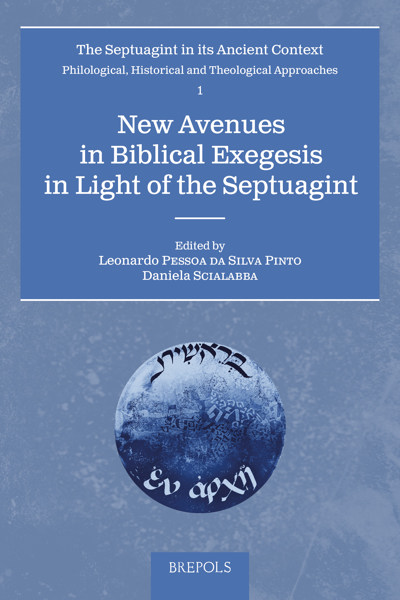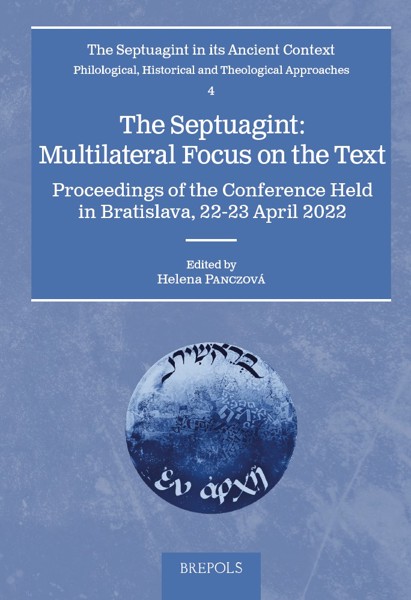
The Septuagint of Ruth
Translation Technique, Textual History, and Theological Issues
Beatrice Bonanno
- Pages: 293 p.
- Size:156 x 234 mm
- Illustrations:32 tables b/w.
- Language(s):English, Greek, Hebrew
- Publication Year:2024
- € 75,00 EXCL. VAT RETAIL PRICE
- ISBN: 978-2-503-61226-3
- Paperback
- Available
- € 75,00 EXCL. VAT RETAIL PRICE
- ISBN: 978-2-503-61227-0
- E-book
- Available
A detailed and systematic study of the translation technique, textual history, and theological accents of the Septuagint of Ruth
“Beatrice Bonanno nel volume che prendiamo in esame si concentra sulla versione della Settanta del libro di Rut, offrendo un’analisi estremamente dettagliata e giungendo a conclusioni importanti sia a riguardo del metodo di ricerca sulla versione greca della Bibbia, sia a riguardo dello stesso libro di Rut. (...)
Il volume consta di nove capitoli ben organizzati e di due appendici, la prima delle quali è un’utilissima sinossi dei testi ebraico, greco, delle varianti greche e delle testimonianze a Qumran. Il testo è scritto con notevole competenza e passione; nonostante l’argomento sia molto di nicchia la sua lettura risulta piacevole ma soprattutto l’argomentazione è convincente. (...)
Questo splendido studio si affianca alla ormai ricca produzione anche italiana (pur se scritta in inglese) sulla Settanta: a testimonianza del fatto che quella antica versione assume una sempre maggiore importanza negli studi biblici e si dimostra del tutto imprescindibile per una adeguata comprensione della Bibbia in quanto tale.” (Matteo Crimella, in Teologia, 50, 2025, pp. 125, 126, 128)
« Cette étude est un apport tout à fait notable pour l’ensemble des recherches en critique textuelle et en techniques de traduction sur la Septante, car elle offre également une méthodologie et de nouvelles approches qui pourront être appliquées aux autres livres. (…) La conclusion de Beatrice Bonanno, qui reprend point par point l’analyse, confirme la créativité effective du traducteur qui sait se détacher du littéral, notamment quand il s’agit de clarifier son texte ou d’y apporter des nuances, parfois théologiques. Cela a été parfaitement prouvé tout au long de son étude, qui atteint son but de réhabilitation du traducteur de Ruth. » (Noémie Kirion-Péan, dans Cahiers d’études du religieux. Recherches interdisciplinaires, en ligne, 27, 2025)
“Bonanno is to be commended for such a granular and well-executed study. She rightly recognizes the importance of Greek Ruth within the textual history of the Septuagint as a whole, specifically in connection with kaige. Her work is full of textual data, lists, and tables that, although sometimes challenging to digest as a reader, provide useful text-critical information and are essential to the content- and context-related approach to translation technique.” (William A. Ross, in Review of Biblical Literature, online, 8, 2025)
Beatrice Bonanno (Palermo, Italy, 1994) studied classical philology at the University of Bologna (Italy) and biblical studies at the Université catholique de Louvain (UCLouvain, Belgium). She obtained her PhD in theology (2022) at the same university, where she is currently a post-doctoral researcher of the Fonds de la Recherche Scientifique (F.R.S.-FNRS), also teaching Biblical Greek. She deepened her knowledge of biblical texts during research stays at the Hebrew University of Jerusalem (Israel), the University of Vienna (Austria), the Arizona State University (Phoenix, AZ), as well as the Phoenix Seminar (Phoenix, AZ).
For many years, the Septuagint of Ruth (LXX-Ruth) has been considered a literal translation. Several authors have emphasized the similarities between the Greek text and the Masoretic Text, while others have also noted the divergences. In the wake of this second stream, this book seeks to answer the crucial question: How can we nuance the definition of “literalism” for LXX-Ruth, and which innovations and specifics can be detected in this text? A fresh analysis of the Greek rendering of the Hebrew proper names, toponyms, hapax legomena as well as legal aspects makes it possible to develop new perspectives on the translation technique of LXX-Ruth and to highlight several characteristics of this text. This volume, moreover, extends the discussion by including the analysis of the theological accents of LXX-Ruth and an up-to-date presentation of its textual history including the fragments of the book in the Dead Sea Scrolls. Overall, this volume enhances our understanding of the linguistic and literary background of the LXX, as well as its specific features.
Introduction
List of abbreviations
Chapter 1: LXX translation technique
Chapter 2: The textual material of the book of Ruth
Chapter 3: Studies on LXX-Ruth
Chapter 4: Catalogue of the textual variants
Chapter 5: Analysis of the Greek rendering of the Hebrew personal names and toponyms as a criterion for characterising the LXX translator’s translation technique
Chapter 6: Analysis of the Greek rendering of the Hebrew hapax legomena as a criterion for characterising the LXX translator’s translation technique
Chapter 7: Analysis of the Greek rendering of the Hebrew legal aspects as a criterion for characterising the LXX translator’s translation technique
Chapter 8: Theological accents in LXX-Ruth
Chapter 9: Conclusions on the characteristics of LXX-Ruth
Appendix 1: Synopsis of the textual material
Appendix 2: A hypothesis regarding the identification of fragment 2 of 2QRuthb? New readings and a textual variant in the Qumran scrolls attesting the book of Ruth
Bibliography
Indices




